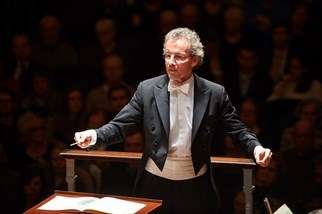|
Back
Transfigured? Great! New York
Isaac Stern Auditorium, Carnegie Hall
02/26/2017 - & February 21 (Wien), 27 (Chapel Hill) 2017
Arnold Schoenberg: Verklärte Nacht, opus 4
Franz Schubert: Symphony No. 9 in C major, “Great”, D. 944
Vienna Philharmonic Orchestra, Franz Welser-Möst (conductor)

F. Welser-Möst (© Roger Mastroianni)
“...the length, the heavenly length of it! It is a whole four-volume novel, longer than the choral symphony. I was supremely happy, and had nothing left to wish for, except that you were my wife...”
Robert Schumann to Clara Wieck, Leipzig, December 11, 1839
Those of you who live in a house with an attic, go up the stairs right now and start rummaging. When Schumann called on Franz Schubert’s brother he discovered the neglected manuscript of the “Great C major” there and passed it on to his dear friend Felix Mendelssohn who prepared it for its world premiere at the Gewandhaus. It is an amazingly forward-looking opus and one of my own personal favorites (although I do know some who refer rather to its “hellish length”).
As authentically Viennese as the Schubert is Schoenberg’s expansion of Transfigured Night from string sextet to full string ensemble. Suggested to the composer by none other than Gustav Mahler, the expansion to string orchestra enhances and deepens the color scheme and reinforces the emotional power of the chamber original which is fittingly the last gasp of the nineteenth century – completed in 1899 – as sure as Beethoven’s 1801 Piano Concerto No. 3 (and particularly the dramatic and groundbreaking first movement cadenza) is the genetic forerunner of the entire 100 year period.
The Vienna Philharmonic is committed to the best possible sound, has held its prominent position for well over a century and a half and is, in fact, exactly the same age as the New York Philharmonic. Since the end of World War II, the orchestra has had different conductors on an ad hoc basis, chosen exclusively by the orchestra members. Their sound is further nurtured and husbanded by having male relatives of current players training for and then assuming regular positions as their family members retire. In furtherance of this unique, hot-housed sound, many instrumentalists are cautioned to always play older (or older styled) instruments, particularly in the brass section where only particular manufacturers are sanctioned. This attention to detail is very much appreciated by audiences, even if many of them have no idea how this unique sonority is fashioned.
So Verklärte Nacht, being written only for string orchestra, introduces even regular Vienna Philharmonic listeners to a new and gorgeously refined acoustical experience. It is a score rich in tonal color and thus a particularly revelatory piece for this ensemble to perform. Of course the wild card in this particular hand is the maestro and, truth be told, I have never been a big fan of Franz Welser-Möst (dubbed “Frankly Worse than Most” by the British press).
The conductor did have an impact on the Schoenberg performance. The beginning was intoned extremely quietly and the melody was allowed to escape organically from the solo violin, viola and cello. Welser-Möst even positioned the violas in the front stage left, mimicking the normal placement in the original sextet (and, coincidentally, in the New York Philharmonic). This was a sensitive performance, although at intermission I heard quite a bit of grumbling from the audience members about having to “sit through” Schoenberg. There were even people in my row who came after the intermission, not wishing to experience any “modern” music!
There was a humorous incident just before the second half of the concert began. The full orchestra was seated in their places when a lagging violinist appeared and headed for his seat. Perhaps he was smoking out on 56th Street and lost track of time (at least he is not a wind player). In any case, when he appeared the crowd gave him a fine ovation as if he were the concertmaster. He quite engagingly acknowledged the applause, summoning a bit of laughter from the crowd. Then Welser-Möst appeared and away we went.
At the Opernhaus in Vienna there are busts of the major opera composers at the time of its construction. One of these heads is that of Schubert and one wonders what actually happened to all of those works for the stage. They are virtually never performed and one wonders why? This image got me thinking about whose contributions were so important in this fine performance. My fantasy is that one need only mount the podium, look at the Vienna Philharmonic and say “Schubert 9”. They would then be able to take it from there.
So Robert and Clara Schumann (played in the film Song of Love by Paul Henreid and Katharine Hepburn) adored this piece and most of us in the audience did as well. We were treated to a fine performance by the Vienna Philharmonic, but where was the contribution of Herr Welser-Möst? Was it the organ-like sound of the Andante con moto? The infectious spirit of the Scherzo, to borrow a phrase from Rob Kapilow, “What Makes It Great?” Or is it the glorious, optimistic, universal message of the final Allegro vivace? Hard to say, but this was music making of a very high order. Michael Tilson Thomas is correct when he states that the music of today would be significantly different if Schubert had led a much longer life.
Although we New Yorkers complain and cry about every little hiccup in our busy lives, where else in America would this concert be opposed by the London Philharmonic under Jurowski performing the Chopin First Concerto and Mahler’s Fourth effort in symphonic form just up the street at Lincoln Center on the same Sunday afternoon? Clearly an embarrassment of riches.
Fred Kirshnit
|